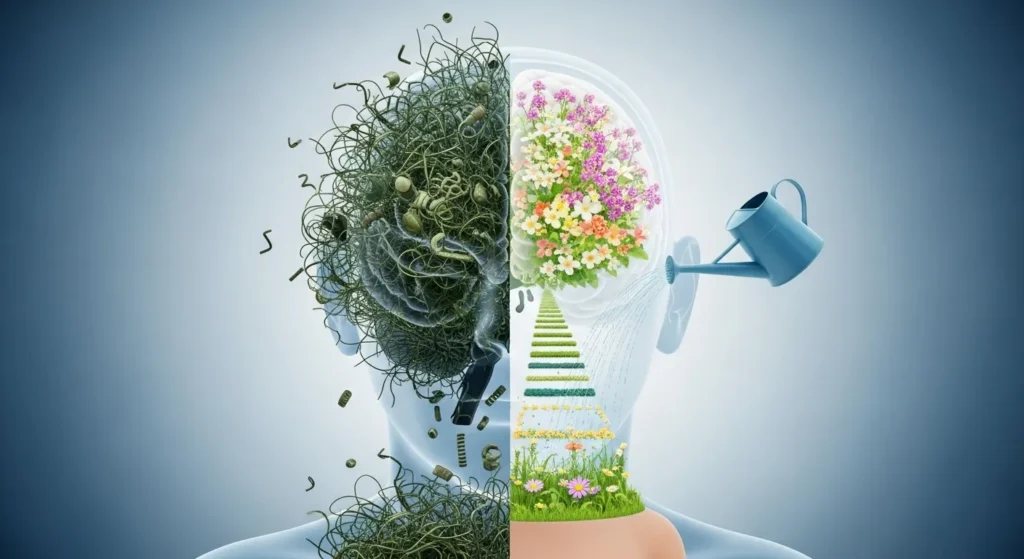Mind Clarity and Mental Focus: Your Daily Guide to Building Unshakeable Inner Balance

We’ve all been there—staring at our to-do list while our mind feels like a browser with 47 tabs open, each one demanding attention. You know that feeling when your thoughts are scattered, your emotional reactions seem to have a mind of their own, and despite your best intentions, that mind clarity you’re desperately seeking feels more like chasing smoke.
Here’s what we’ve learned after years of coaching people through this exact struggle: mental focus isn’t about forcing your brain into submission or pretending everything’s fine when it’s not. It’s about creating space—real, breathing space—between you and the mental chaos so you can respond instead of just react.
I’m Federico, and together with Giulia, we’ve spent the last decade exploring what actually works for building sustainable emotional balance without the fluff or the pressure to be perpetually positive. We’re not here to sell you another productivity hack or tell you to “just think positive.” Instead, we want to share the practical, science-backed strategies that have helped thousands of people (including ourselves) develop genuine deep focus and mental resilience.
The truth? Most of us were never taught how to work with our minds rather than against them. We were told to push through, stay strong, and keep going—but nobody showed us how to actually cultivate the inner stability that makes everything else possible.
That’s exactly what we’re diving into today.
Mind Clarity: Why Emotional Balance Is Essential for Everyday Resilience
Let’s start with something that might surprise you: mental clarity doesn’t come from having fewer thoughts or emotions. It comes from developing a different relationship with them entirely.
Think about it this way—when you’re driving in heavy traffic, you don’t try to make the other cars disappear. You learn to navigate skillfully, stay calm, and focus on what you can control. Your mind works the same way.
Mental Clarity Before Control: A New Perspective
We used to think that mental strength meant controlling our thoughts and emotions. Turns out, that’s like trying to hold water in your hands—the tighter you squeeze, the more it slips through your fingers.
Real mental focus starts with clarity about what’s actually happening in your inner world. When you can observe your thoughts and feelings without immediately judging them as “good” or “bad,” something interesting happens: they lose their power to hijack your entire day.
Here’s a simple example from our own experience. Giulia used to get completely derailed by anxiety about upcoming presentations. She’d spend days in a mental loop, imagining worst-case scenarios and feeling increasingly overwhelmed.
The breakthrough came when she stopped trying to eliminate the anxiety and instead got curious about it. What exactly am I feeling? Where do I notice it in my body? What thoughts are feeding this feeling?
This shift from fighting to observing created space for her natural wisdom to emerge. She could prepare thoughtfully without getting lost in catastrophic thinking.
A landmark study from Harvard published in Science found that people are substantially less happy when their minds are wandering than when they are focused, suggesting that mental clarity and the ability to stay present are directly tied to emotional balance.
Self-Coaching as a Daily Practice
This is where mindful self discipline becomes your secret weapon for mind clarity. Not the harsh, drill-sergeant kind of discipline, but the gentle, consistent practice of checking in with yourself throughout the day.
We like to think of it as becoming your own best coach—someone who notices when you’re struggling, offers support without judgment, and helps you redirect your energy toward what actually matters.
Three key elements of effective self-coaching:
- Awareness without analysis paralysis – Notice what’s happening without needing to fix it immediately
- Compassionate curiosity – Ask “What do I need right now?” instead of “What’s wrong with me?”
- Gentle redirection – Guide your attention back to your values and priorities when you drift
The beauty of this approach is that it works with your natural rhythms instead of demanding perfection. Some days you’ll feel sharp and focused. Other days, you’ll feel scattered and emotional. Both are completely normal parts of being human.
Simple Practices to Reconnect and Regulate
Now, let’s get practical. These aren’t complex techniques that require hours of your day—they’re simple tools you can use anywhere, anytime, to restore your sense of emotional balance and mental clarity.
Breathwork, Journaling, and Movement
The 4-7-8 Reset: When your mind feels chaotic, this breathing pattern can help you find your center in under two minutes. Breathe in for 4 counts, hold for 7, exhale for 8. Repeat 3-4 times. The extended exhale activates your parasympathetic nervous system, naturally calming your mind and body.
We discovered this technique during a particularly stressful period when traditional meditation felt impossible. Sometimes you need something more active than sitting quietly with your thoughts.
Stream-of-consciousness journaling: Set a timer for 10 minutes and write whatever comes to mind without stopping or editing. This isn’t about creating beautiful prose—it’s about clearing mental clutter so you can access your deeper wisdom.
The key is writing by hand if possible. There’s something about the physical act of forming letters that helps process emotions and thoughts differently than typing.
Movement as medicine: This doesn’t mean you need to hit the gym for an hour. Even 5-10 minutes of intentional movement can shift your mental state completely. Dance to one favorite song, do some gentle stretches, or take a brief walk while paying attention to your surroundings.
Movement helps metabolize stress hormones and often provides the mental reset you didn’t know you needed.
The Power of Micro-Moments of Awareness
Here’s where the magic really happens—in those tiny moments throughout your day when you pause and reconnect with yourself. We call these micro-moments of awareness, and they’re incredibly powerful for building sustained mental focus.
The Stop, Look, Listen technique:
- Stop what you’re doing for just 30 seconds
- Look around and notice three things in your environment
- Listen to the sounds around you and take one conscious breath
This simple practice helps interrupt autopilot mode and brings you back to the present moment. You can do this while waiting for your coffee to brew, before checking your phone, or transitioning between tasks.
The body scan check-in: Throughout the day, briefly scan your body from head to toe. Where are you holding tension? What sensations do you notice? This isn’t about fixing anything—just gathering information about your current state.
These practices might seem almost too simple to be effective, but that’s exactly why they work. You’re training your nervous system to find calm and clarity without adding more stress to your life.
Building Inner Strength Without Toxic Positivity
Let’s address the elephant in the room: the pressure to maintain a positive mindset all the time. We’ve seen too many people exhaust themselves trying to think their way into feeling better, and frankly, it’s not sustainable or healthy.
True mental clarity includes space for the full spectrum of human emotions—including the uncomfortable ones.
Reframing Mindset with Curiosity
Instead of forcing positive thoughts, what if you approached challenging emotions with curiosity? This subtle shift can transform your entire relationship with difficult feelings.
When you notice yourself thinking, “I shouldn’t feel this way,” try replacing it with, “I wonder what this feeling is trying to tell me?”
The RAIN approach has been incredibly helpful for us and our clients:
- Recognize what you’re experiencing
- Allow it to be there without fighting it
- Investigate with kindness what you need
- Nurture yourself with the same compassion you’d offer a good friend
This isn’t about dwelling in negative emotions—it’s about processing them skillfully so they don’t get stuck in your system and create ongoing mental fog.
Habits That Gently Support Growth
A growth mindset isn’t about believing you can achieve anything if you just try hard enough. It’s about trusting your ability to learn, adapt, and develop resilience over time.
The habits that truly support mental clarity are often surprisingly gentle:
Morning intention setting: Instead of a rigid morning routine, try setting one simple intention for the day. It might be “I’ll respond instead of react” or “I’ll notice when I need to pause and breathe.”
Evening reflection: Before bed, briefly consider: What went well today? What did I learn? What am I grateful for? This isn’t about productivity analysis—it’s about acknowledging your growth and building positive neural pathways.
Boundary practice: Mindful self discipline includes saying no to things that drain your energy unnecessarily. Start small—maybe it’s not checking emails after a certain time or taking a few minutes before responding to requests.
Our Story: Real-Life Tools for a Grounded Mind
We want to share something personal with you because authenticity matters when it comes to mental focus and emotional balance.
Why We Started Self-Coaching
A few years ago, Federico was dealing with what felt like constant mental overwhelm. Despite having successful coaching practices, he found himself caught in cycles of procrastination and self-criticism that seemed impossible to break.
Traditional productivity advice wasn’t working. If anything, it was making things worse by adding another layer of “shoulds” to an already overloaded mind.
That’s when we realized something crucial: how to program your subconscious mind isn’t about affirmations or visualization alone. It’s about creating consistent, gentle practices that help your nervous system feel safe enough to access your natural clarity and creativity.
What Worked (and What Didn’t)
What didn’t work:
- Trying to meditate for 30+ minutes when we were already stressed
- Forcing gratitude practices when we were genuinely struggling
- Using productivity systems that felt more like mental prison than support
- Pushing through fatigue and emotional exhaustion in the name of discipline
What transformed everything:
- Starting with just 2-3 minutes of conscious breathing
- Allowing ourselves to feel difficult emotions without immediately trying to fix them
- Creating simple, flexible routines that could adapt to our energy levels
- Learning to distinguish between healthy challenge and unhealthy stress
The biggest shift came when we stopped trying to eliminate stress and started learning how to work with it skillfully. Stress isn’t the enemy—chronic, unprocessed stress is.
Giulia’s breakthrough moment came during a particularly challenging period when she realized she’d been treating her emotions like problems to solve rather than information to process. Once she started approaching her inner world with curiosity instead of criticism, her natural mental clarity began to emerge.
How to Start Your Own Mental Clarity Practice
Ready to begin? The key is starting small and building gradually. Your brain learns through repetition and consistency, not intensity.
Pick Your Daily Anchor
Choose one simple practice that you’ll commit to for the next two weeks. This becomes your anchor—something you return to every day regardless of how you’re feeling.
Some options to consider:
- 5 minutes of morning breathing or stretching
- A brief gratitude reflection before meals
- A short walk without your phone
- 10 minutes of stream-of-consciousness journaling
The practice matters less than the consistency. You’re training your nervous system to find calm and clarity regularly, not just when you’re already feeling good.
Use Free Tracker or Journal Guide
We’ve found that having some structure helps, especially in the beginning. To get started, you don’t need fancy apps or expensive tools—a simple notebook works perfectly.
Try this simple daily tracking:
- Energy level (1-10)
- Mood (one word)
- Stress level (1-10)
- One thing you’re grateful for
- One thing you learned about yourself
After a week or two, you’ll start noticing patterns that can guide your self-coaching practice.
Other Tools for Calm and Clarity
While simple practices are the foundation, having the right tools can enhance your journey toward mental focus and emotional balance.
Apps we genuinely recommend:
- Headspace for guided meditations that don’t feel overwhelming
- Insight Timer for a huge library of free meditations and talks
- Forest for maintaining focus during work sessions without feeling restricted
Physical tools that make a difference:
- A dedicated journal for your mental clarity practice (we love the Five Minute Journal for its simplicity)
- Essential oils like lavender or peppermint for sensory anchoring during stressful moments
- A comfortable meditation cushion or chair that signals to your brain it’s time to pause
Remember, these are supports for your practice, not replacements for it. The most powerful tool you have is your own awareness and commitment to treating yourself with kindness.
What’s Next?
Here’s what we want you to remember: mind clarity isn’t a destination you reach and then maintain effortlessly. It’s a practice—a way of relating to yourself and your inner world that gets stronger over time.
You don’t need to be perfect at this. You don’t need to meditate for hours or eliminate all stress from your life. You just need to start where you are, with what you have, and trust your capacity to grow.
Having a positive mindset doesn’t mean forcing happiness—it means trusting yourself to handle whatever comes your way with grace and wisdom. Mindset is everything not because you can think your way out of problems, but because how you relate to challenges determines your experience of them.
The path to emotional balance is built one conscious breath, one moment of self-compassion, and one gentle choice at a time. Your mind has an incredible capacity for clarity and peace—sometimes it just needs a little support and guidance to remember how to access it.
Start today. Start small. Start with kindness toward yourself. Your future self will thank you for every moment you invest in building this inner foundation. And remember—we’re here to support you every step of the way.
Disclaimer: The information provided is for educational purposes only, not a substitute for professional medical advice. Always consult a healthcare professional.







